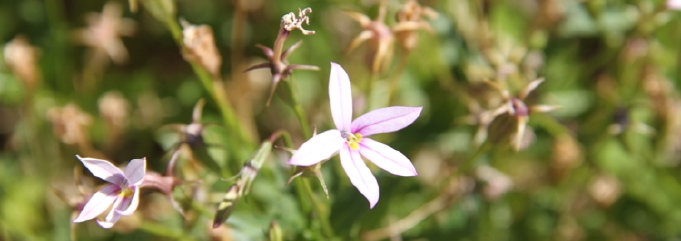Australia So Much to See
Copyright (C) 2013 AustraliaSoMuchtoSee.com. All reights reserved


Big Rock tour of November 2012
Rusty the dog greets visitors to the town at the western entrance. Rusty the tin dog was born in 2004 when the children from
Dowerin District High School developed a project initiative to encourage people to stop in Dowerin. The students helped with Rusty’s
initial design, sourced funding for his materials and employed an artist to build him.
The students were inspired by the legend
of his home, Tin Dog Creek which originally got its name during settlement in the area and the commencement of mining in the
Yilgarn Goldfields. Those travelling though left empty cans from the canned beef they carried alongside the creek as they camped,
giving the name Tin Dog Creek.
From Goomalling we continued to Dowerin, the home of the successful Dowerin Machinery Field Days. Commenced on a small
scale in 1964, the two day event has grown into the biggest rural field day of its type in Western Australia. Held in August
each year the Field Days cover all aspects of agriculture, not just machinery.
One source suggests Dowerin is the Aboriginal
word for the twenty eight parrot (Dow-arn), and another suggests it means "place of the throwing stick"(dower).
The winding road into Toodyay and further towards Goomalling is scenic, but one to watch due to the nature of the terrain, traffic
volume and accident rate. In 1836 Toodyay was referred to as "Duidgee", and some references refer to it as possibly named after
the Aboriginal Toodyeep who was the wife of the Coondebung who accompanied Moore & Dale in exploring the area in 1831. Goomalling
is an Aboriginal word which means "the place of the silver-grey possum".
We travelled via Narrogin and the Great Southern Highway to York, then west towards Perth and north to Wundowie where there is a large
smelter which is now closed down. Wundowie derives its name from Woondowing Spring, an Aboriginal name for a nearby spring.
Building of the Iron and Steel works commenced in 1943 and was officially opened 15 April 1948. The location was chosen
in part because of access to forests and a timber mill from which waste timber could be used to produce charcoal be used with the
locally mined iron ore to produce pig iron and pyroligneous acid which was refined to give acetic acid, methanol and other products.
Local ore proved to be poor, so high quality ore was brought by rail from Koolyanobbing to produce a very high quality pig iron, due
to the use of the locally produced charcoal.
Although the smelter ceased operating in 1981, it remains as a reminder of
the beginnings of the iron ore industry in Western Australia.
Read more on the history of the Wundowie Smelter on Wikipedia
Western Australia has some massive granite rocks and a number of these are now set in nature reserves, often with picnic facilities
some allowing camping. Some have wave faces and small caverns with colours and textures from centuries of weathering. Many
of these rocks can be seen in the wheatbelt and our small group of caravanners set out to visit some of these.
Our tour
was based on the Golden Outback Granite Loop Trail, although we were too late in the season for most of the wildflowers which this self
drive tour features in spring.
We spent a night at the small free Minnivale Campground at Minnivale Siding twenty one kilometres from Dowerin. The former town
site is now virtually surrounded by a nature reserve and only a few inhabited houses remain. The grain collection bin is no
longer used.
This campground beside the disused tennis courts provides one unisex flushing toilet, a dump
point and hose, and a cold shower. The shower which has been placed in what was the second toilet cubicle has no door, curtain
or hooks, but a good thick rubber mat on the floor under the shower.
The colourful painted building to the right is the shower,
and the dump point and hose is in front of it.
Passing through Nungarin, next was a visit to Mount Moore (Talgomine Rock) in the Talgomine Nature Reserve. This hill a symmetrical
granite outcrop which was used as a landmark for the turnaround point for World War II training flights. The Aboriginal
name for the town was first recorded by surveyors as Noongorin in 1864.
We revisit and tour Nungarin and surrounds in 2021.
Water oozed out of ledges in the rocks, and this was more evident in the early morning than at the end of the day when evaporation
had taken effect.
Stopping at Trayning for lunch, we found it a neat small town with a pleasant and well provisioned park for travellers together with
a war memorial. Reading the names of those who lost their lives in the Wars all the sadder when from this very small community
so many with the same surname were most likely all from the same family.
The townsite is named after Trayning Well, believed
to be derived from Duranning, meaning snake crawling in the grass near camp site.
From Minnivale we returned south to the Goomalling Wyalkatchem Road and continued to Wyalkatchem, which like so many of these wheatbelt
towns go out of their way to welcome visitors.
At Wyalkatchem we stopped to photograph these flowers complete with insects near
the caravan park.
Wyalkatchem is an Aboriginal name first recorded for a waterhole spelt Walkatching
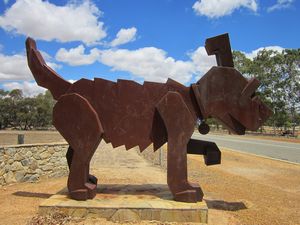
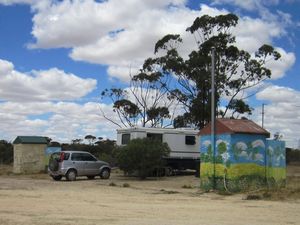
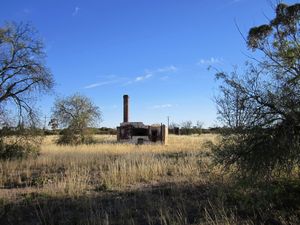
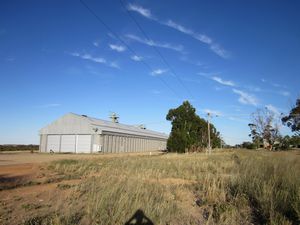
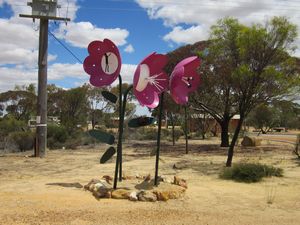
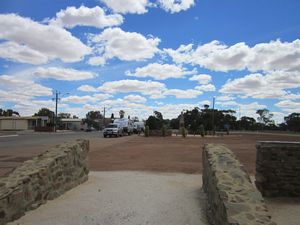
On this page we feature Dowerin, Talgomine Rock near Nungarin and Yanneymooning Rock in the Yanneymooning Nature Reserve.
We head further south in the wheatbelt as see a unique pink and blue lake near Quairading and
continue further south to visit Cuballing.
The field days grew out of a Dowerin Progress Association meeting held in 1964 with the aim of trying to find ways of preventing Dowerin
becoming a ghost town, (a not uncommon fate of Wheatbelt communities across Australia). One of those attending had just returned
from visiting a field day in Orange (New South Wales) and suggested Dowerin hold a similar event. The inaugural field day was held
on Friday 3rd September 1965 and it has grown annually since that inception.
A walk around the townsite shows the extent it used to cover.
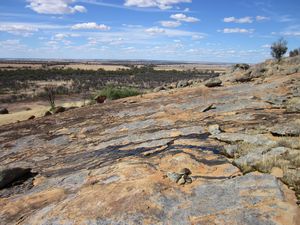
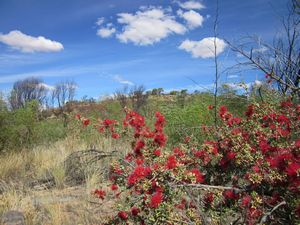
At the base of the rock red flowering Granite Kunzea shrubs were vivid. These shrubs were scattered on the rock itself, right
to the top.
Talgomine Rock, officially Mount Moore, in the Talgomine Reserve, in the Shire of Nungarin, is a very easy rock to climb, being
just a gentle incline. With the surrounding land being relatively flat, climbers have views across the surrounding farms
and to Lake Campion to the north.
This remote and unserviced reserve was an ideal place for our small group to stay for
the night and walk on the rock in the morning.
Taking rural roads north towards Mukinbudin we passed another large rock at Knungajin pumping station. This is not far from
Eaglestone Rock, in the shire in Nungarin.
Mukinbudin is a neat town where we stopped to get a few supplies. The
name is Aboriginal, and was first recorded for Muckenbooding Rock in 1889.
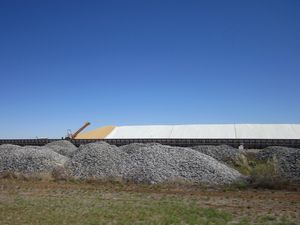
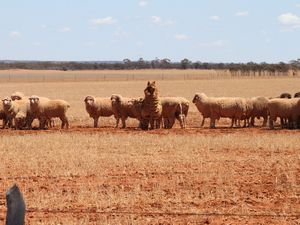
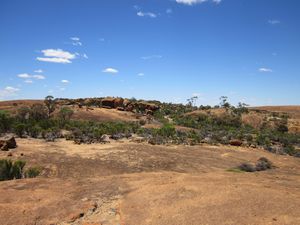
Yanneymooning Nature Reserve covers an area of almost 540 hectares. It is approximately 30 kilometres north east of Mukinbudin. The majority of this reserve consists of three distinctly peaked but interlinked rocks.
This was a rare opportunity to photograph livestock on a farm. Many of the wheatbelt farms no longer run sheep. Sheep
numbers in Western Australia at fourteen million are down to around a third of the numbers run in 1990 due to cost of production
against wool prices, and seasonal conditions. This reduction is much in line with national figures.
We saw two Alpacas with some sheep. Anyone got shearing gear handy? These appeared to be carrying several years' fleece.
